Preventing the Separation of Urban Humans from Nature: The Impact of Pet and Plant Diversity on Biodiversity Loss Belief
Abstract
1. Introduction
- To examine whether Vietnamese urban residents’ access to diversity of in-home animals and plants is associated with their belief in biodiversity loss.
- To examine whether the associations between urban residents’ access to in-home biodiversity and belief in biodiversity loss are moderated by their feeling of comfort in the house.
2. Methodology
2.1. Theoretical Foundation
2.1.1. Mindsponge Theory Overview
- It reflects the natural patterns of systems in the biosphere.
- It is a process that is dynamically balanced.
- It involves a cost–benefit evaluation, which aims to increase the perceived benefits and reduce the perceived costs of the system.
- It consumes energy and thus adheres to the principle of energy saving.
- It has a goal or goals and priority, depending on the demands of the system.
- Its fundamental purpose is to prolong the system’s existence in one way or another, including survival, growth, and reproduction.
2.1.2. Environment and Biodiversity Loss Belief Formulation
2.2. Model Construction
2.2.1. Variable Selection and Rationale
- https://direct.mit.edu/dint/article/3/4/578/107428/Multifaceted-Interactions-between-Urban-Humans-and (accessed on 2 October 2022).
2.2.2. Statistical Models
2.3. Analysis and Validation
3. Results
4. Discussion and Conclusions
Supplementary Materials
Author Contributions
Funding
Data Availability Statement
Conflicts of Interest
References
- Elmqvist, T.; Redman, C.L.; Barthel, S.; Costanza, R. History of urbanization and the missing ecology. In Urbanization, Biodiversity Ecosystem Services: Challenges Opportunities: A Global Assessment; Elmqvist, T., Fragkias, M., Goodness, J., Güneralp, B., Marcotullio, P.J., McDonald, R.I., Parnell, S., Schewenius, M., Sendstad, M., Seto, K.C., et al., Eds.; Springer Nature: London, UK, 2013; pp. 13–30. [Google Scholar]
- Costanza, R.; Graumlich, L.J.; Steffen, W. Sustainability or Collapse?: An Integrated History and Future of People on Earth; MIT Press: Cambridge, MA, USA, 2011. [Google Scholar]
- Elmqvist, T.; Fragkias, M.; Goodness, J.; Güneralp, B.; Marcotullio, P.J.; McDonald, R.I.; Parnell, S.; Schewenius, M.; Sendstad, M.; Seto, K.C. Urbanization, Biodiversity and Ecosystem Services: Challenges and opportunities: A Global Assessment; Springer Nature: Berlin/Heidelberg, Germany, 2013. [Google Scholar]
- Rees, J. Industrialization and Urbanization in the United States, 1880–1929; Oxford University Press: Oxford, UK, 2016. [Google Scholar]
- Bairoch, P.; Goertz, G. Factors of urbanisation in the nineteenth century developed countries: A descriptive and econometric analysis. Urban Stud. 1986, 23, 285–305. [Google Scholar] [CrossRef]
- Davis, K. The origin and growth of urbanization in the world. Am. J. Sociol. 1955, 60, 429–437. [Google Scholar] [CrossRef]
- Dobbs, R.; Smit, S.; Remes, J.; Manyika, J.; Roxburgh, C.; Restrepo, A. Urban World: Mapping the Economic Power of Cities; McKinsey Global Institute: 2011. Available online: https://www.mckinsey.com/~/media/mckinsey/featured%20insights/urbanization/urban%20world/mgi_urban_world_mapping_economic_power_of_cities_full_report.ashx (accessed on 28 January 2023).
- Nguyen, M.-H.; Le, T.-T.; Vuong, Q.-H. Ecomindsponge: A novel perspective on human psychology and behavior in the ecosystem. Urban Sci. 2023, 7, 31. [Google Scholar] [CrossRef]
- Turner, W.R.; Nakamura, T.; Dinetti, M. Global urbanization and the separation of humans from nature. BioScience 2004, 54, 585–590. [Google Scholar] [CrossRef]
- Tam, K.-P. Concepts and measures related to connection to nature: Similarities and differences. J. Environ. Psychol. 2013, 34, 64–78. [Google Scholar] [CrossRef]
- Barrable, A.; Booth, D. Disconnected: What can we learn from individuals with very low nature connection? Int. J. Environ. Res. Public Health 2022, 19, 8021. [Google Scholar] [CrossRef]
- Steffen, W.; Richardson, K.; Rockström, J.; Cornell, S.E.; Fetzer, I.; Bennett, E.M.; Biggs, R.; Carpenter, S.R.; De Vries, W.; De Wit, C.A. Planetary boundaries: Guiding human development on a changing planet. Science 2015, 347, 1259855. [Google Scholar] [CrossRef] [PubMed]
- Lenton, T.M.; Rockström, J.; Gaffney, O.; Rahmstorf, S.; Richardson, K.; Steffen, W.; Schellnhuber, H.J. Climate tipping points—Too risky to bet against. Nature 2019, 575, 592–595. [Google Scholar] [CrossRef]
- Grainger, A. Difficulties in tracking the long-term global trend in tropical forest area. Proc. Natl. Acad. Sci. USA 2008, 105, 818–823. [Google Scholar] [CrossRef]
- IPCC. Climate Change 2021: The Physical Science Basis. Contribution of Working Group I to the Sixth Assessment Report of the Intergovernmental Panel on Climate Change; Cambridge University Press: Cambridge, UK; New York, NY, USA, 2021. [Google Scholar]
- Outka, U.; Warner, E.K. Reversing course on environmental justice under the Trump administration. Wake For. Law Rev. 2019, 54, 393. [Google Scholar]
- Dunlap, R.E.; McCright, A.M. Climate change denial: Sources, actors and strategies. In Routledge Handbook of Climate Change and Society; Constance, L.-T., Ed.; Routledge: Abingdon-on-Thames, UK, 2010; pp. 240–259. [Google Scholar]
- Editorial. Biodiversity centre stage. Nat. Ecol. Evol. 2019, 3, 861. Available online: https://www.nature.com/articles/s41559-019-0922-2 (accessed on 28 January 2023). [CrossRef]
- Lees, A.C.; Attwood, S.; Barlow, J.; Phalan, B. Biodiversity scientists must fight the creeping rise of extinction denial. Nat. Ecol. Evol. 2020, 4, 1440–1443. [Google Scholar] [CrossRef]
- De Leeuw, A.; Valois, P.; Ajzen, I.; Schmidt, P. Using the theory of planned behavior to identify key beliefs underlying pro-environmental behavior in high-school students: Implications for educational interventions. J. Environ. Psychol. 2015, 42, 128–138. [Google Scholar] [CrossRef]
- Johnson, D.N.; Shipley, N.J.; van Riper, C.J.; Kyle, G.T.; Wallen, K.E.; Landon, A.; Absher, J. Place-based motivations and normative beliefs predict pro-environmental behavior across involvement profiles. J. Outdoor Recreat. Tour. 2021, 35, 100377. [Google Scholar] [CrossRef]
- Ajzen, I. From intentions to actions: A theory of planned behavior. In Action Control; Kuhl, J., Beckmann, J., Eds.; Springer: Berlin/Heidelberg, Germany, 1985; pp. 11–39. [Google Scholar]
- Ajzen, I. The theory of planned behavior. Organ. Behav. Hum. Decis. Process. 1991, 50, 179–211. [Google Scholar] [CrossRef]
- O’Connor, R.E.; Bard, R.J.; Fisher, A. Risk perceptions, general environmental beliefs, and willingness to address climate change. Risk Anal. 1999, 19, 461–471. [Google Scholar] [CrossRef]
- Lou, T.; Wang, D.; Chen, H.; Niu, D. Different perceptions of belief: Predicting household solid waste separation behavior of urban and rural residents in China. Sustainability 2020, 12, 7778. [Google Scholar] [CrossRef]
- Gadenne, D.; Sharma, B.; Kerr, D.; Smith, T. The influence of consumers’ environmental beliefs and attitudes on energy saving behaviours. Energy Policy 2011, 39, 7684–7694. [Google Scholar] [CrossRef]
- Vuong, Q.-H. Mindsponge Theory; De Gruyter: Berlin, Germany, 2023; Available online: https://www.amazon.com/Mindsponge-Analytics-Innovative-Thinking-Humanities/dp/8367405102/ (accessed on 13 January 2023).
- Vuong, Q.-H.; Napier, N.K. Acculturation and global mindsponge: An emerging market perspective. Int. J. Intercult. Relat. 2015, 49, 354–367. [Google Scholar] [CrossRef]
- Vuong, Q.-H.; Le, T.-T.; Jin, R.; Khuc, Q.V.; Nguyen, H.-S.; Vuong, T.-T.; Nguyen, M.-H. Near-suicide phenomenon: An investigation into the psychology of patients with serious illnesses withdrawing from treatment. Int. J. Environ. Res. Public Health 2023, 20, 5173. [Google Scholar] [CrossRef] [PubMed]
- Nguyen, M.-H.; Jones, T.E. Building eco-surplus culture among urban residents as a novel strategy to improve finance for conservation in protected areas. Humanit. Soc. Sci. Commun. 2022, 9, 426. [Google Scholar] [CrossRef]
- Nguyen, M.-H.; Jones, T.E. Predictors of support for biodiversity loss countermeasures and bushmeat consumption among Vietnamese urban residents. Conserv. Sci. Pract. 2022, 4, e12822. [Google Scholar] [CrossRef]
- Vuong, Q.-H.; Nguyen, M.-H.; Le, T.-T. A Mindsponge-Based Investigation into the Psycho-Religious Mechanism Behind Suicide Attacks; De Gruyter: Berlin, Germany, 2021. [Google Scholar]
- Vuong, Q.-H. Meandering Sobriety; AISDL: Hanoi, Vietnam, 2023; Available online: https://www.amazon.com/dp/B0C2TXNX6L/ (accessed on 19 April 2023).
- Vuong, Q.-H.; Nguyen, M.-H.; La, V.-P. The Mindsponge and BMF Analytics for Innovative Thinking in Social Sciences and Humanities; De Gruyter: Berlin, Germany, 2022. [Google Scholar]
- Connors, M.H.; Halligan, P.W. A cognitive account of belief: A tentative road map. Front. Psychol. 2015, 5, 1588. [Google Scholar] [CrossRef]
- Alberini, C.M.; Kandel, E.R. The regulation of transcription in memory consolidation. Cold Spring Harb. Perspect. Biol. 2015, 7, a021741. [Google Scholar] [CrossRef] [PubMed]
- Bernstein, C. DNA methylation and establishing memory. Epigenetics Insights 2022, 15, 25168657211072499. [Google Scholar] [CrossRef]
- Bliss, T.V.; Collingridge, G.L. A synaptic model of memory: Long-term potentiation in the hippocampus. Nature 1993, 361, 31–39. [Google Scholar] [CrossRef] [PubMed]
- Eagleman, D. The Brain: The Story of You; Canongate Books: Edinburgh, UK, 2015; p. 273. [Google Scholar]
- Gill, J. Bayesian Methods: A Social and Behavioral Sciences Approach; CRC Press: Boca Raton, FL, USA, 2014; Volume 20. [Google Scholar]
- Suchow, J.W.; Bourgin, D.D.; Griffiths, T.L. Evolution in mind: Evolutionary dynamics, cognitive processes, and bayesian inference. Trends Cogn. Sci. 2017, 21, 522–530. [Google Scholar] [CrossRef]
- Nguyen, M.-H.; La, V.-P.; Le, T.-T.; Vuong, Q.-H. Introduction to Bayesian Mindsponge Framework analytics: An innovative method for social and psychological research. MethodsX 2022, 9, 101808. [Google Scholar] [CrossRef]
- Clark, N.E.; Lovell, R.; Wheeler, B.W.; Higgins, S.L.; Depledge, M.H.; Norris, K. Biodiversity, cultural pathways, and human health: A framework. Trends Ecol. Evol. 2014, 29, 198–204. [Google Scholar] [CrossRef] [PubMed]
- Myers, Z. Wildness and Wellbeing: Nature, Neuroscience, and Urban Design; Springer: Berlin/Heidelberg, Germany, 2020; Available online: https://www.amazon.com/Wildness-Wellbeing-Nature-Neuroscience-Design/dp/9813299223 (accessed on 28 January 2023).
- Wood, E.; Harsant, A.; Dallimer, M.; Cronin de Chavez, A.; McEachan, R.R.; Hassall, C. Not all green space is created equal: Biodiversity predicts psychological restorative benefits from urban green space. Front. Psychol. 2018, 9, 2320. [Google Scholar] [CrossRef]
- Bergou, N.; Hammoud, R.; Smythe, M.; Gibbons, J.; Davidson, N.; Tognin, S.; Reeves, G.; Shepherd, J.; Mechelli, A. The mental health benefits of visiting canals and rivers: An ecological momentary assessment study. PLoS ONE 2022, 17, e0271306. [Google Scholar] [CrossRef]
- VietNamNet Bridge. Hanoi’s Shrinking Green Space. Available online: https://vietnamnet.vn/en/hanois-shrinking-green-space-E194692.html (accessed on 5 March 2023).
- Nguyen, N. Where Have Saigon’s Green Spaces Gone? Available online: https://e.vnexpress.net/projects/where-have-saigon-s-green-spaces-gone-3599035/index.html (accessed on 5 March 2023).
- Kruger, K.S.; Stern, S.L.; Anstead, G.; Finley, E.P. Perceptions of companion dog benefits on well-being of US military veterans with HIV/AIDS. South. Med. J. 2014, 107, 188–193. [Google Scholar] [CrossRef]
- Wood, L.; Martin, K.; Christian, H.; Nathan, A.; Lauritsen, C.; Houghton, S.; Kawachi, I.; McCune, S. The pet factor-companion animals as a conduit for getting to know people, friendship formation and social support. PLoS ONE 2015, 10, e0122085. [Google Scholar] [CrossRef] [PubMed]
- Kaplan, R.; Kaplan, S. The Experience of Nature: A Psychological Perspective; Cambridge University Press: Cambridge, UK, 1989. [Google Scholar]
- Raymond, C.M.; Diduck, A.P.; Buijs, A.; Boerchers, M.; Moquin, R. Exploring the co-benefits (and costs) of home gardening for biodiversity conservation. Local Environ. 2019, 24, 258–273. [Google Scholar] [CrossRef]
- Zhang, X.; Zhang, Y.; Zhai, J. Home garden with eco-healing functions benefiting mental health and biodiversity during and after the COVID-19 pandemic: A scoping review. Front. Public Health 2021, 9, 740187. [Google Scholar] [CrossRef] [PubMed]
- Samus, A.; Freeman, C.; Dickinson, K.J.; Van Heezik, Y. Relationships between nature connectedness, biodiversity of private gardens, and mental well-being during the Covid-19 lockdown. Urban For. Urban Green. 2022, 69, 127519. [Google Scholar] [CrossRef]
- Phillipou, A.; Tan, E.J.; Toh, W.L.; Van Rheenen, T.E.; Meyer, D.; Neill, E.; Sumner, P.J.; Rossell, S.L. Pet ownership and mental health during COVID-19 lockdown. Aust. Vet. J. 2021, 99, 423–426. [Google Scholar] [CrossRef] [PubMed]
- Gia, K. Hàng Xóm từ mặt Nhau vì "Cuộc Chiến" nuôi Chó mèo ở Chung cư. Available online: https://danviet.vn/nuoi-cho-meo-o-chung-cu-hang-xom-tu-mat-nhau-cai-nhau-20221023224407306.htm (accessed on 6 March 2023).
- Frey, B.S.; Luechinger, S.; Stutzer, A. The life satisfaction approach to valuing public goods: The case of terrorism. Public Choice 2009, 138, 317–345. [Google Scholar] [CrossRef]
- Welsch, H. Environment and happiness: Valuation of air pollution using life satisfaction data. Ecol. Econ. 2006, 58, 801–813. [Google Scholar] [CrossRef]
- Nguyen, M.-H. Multifaceted interactions between urban humans and biodiversity-related concepts: A developing-country dataset. Data Intell. 2021, 3, 578–605. [Google Scholar] [CrossRef]
- Creswell, J.W.; Poth, C.N. Qualitative Inquiry and Research Design: Choosing among Five Approaches; Sage Publications: Thousand Oaks, CA, USA, 2016. [Google Scholar]
- Csilléry, K.; Blum, M.G.; Gaggiotti, O.E.; François, O. Approximate Bayesian computation (ABC) in practice. Trends Ecol. Evol. 2010, 25, 410–418. [Google Scholar] [CrossRef]
- Dunson, D.B. Commentary: Practical advantages of Bayesian analysis of epidemiologic data. Am. J. Epidemiol. 2001, 153, 1222–1226. [Google Scholar] [CrossRef]
- Wagenmakers, E.-J.; Marsman, M.; Jamil, T.; Ly, A.; Verhagen, J.; Love, J.; Selker, R.; Gronau, Q.F.; Šmíra, M.; Epskamp, S. Bayesian inference for psychology. Part I: Theoretical advantages and practical ramifications. Psychon. Bull. Rev. 2018, 25, 35–57. [Google Scholar] [CrossRef] [PubMed]
- Halsey, L.G.; Curran-Everett, D.; Vowler, S.L.; Drummond, G.B. The fickle P value generates irreproducible results. Nat. Methods 2015, 12, 179–185. [Google Scholar] [CrossRef]
- Diaconis, P.; Ylvisaker, D. Quantifying prior opinion. In Bayesian Statistics; Bernardo, J.M., DeGroot, M.H., Lindley, D.V., Smith, A.F.M., Eds.; North Holland Press: Amsterdam, The Netherlands, 1985; Volume 2, pp. 133–156. [Google Scholar]
- Vehtari, A.; Gelman, A.; Gabry, J. Practical Bayesian model evaluation using leave-one-out cross-validation and WAIC. Stat. Comput. 2017, 27, 1413–1432. [Google Scholar] [CrossRef]
- Vehtari, A.; Gabry, J. Bayesian Stacking and Pseudo-BMA Weights Using the loo Package, loo 2.2.0; 2019. Available online: https://mc-stan.org/loo/articles/loo2-weights.html (accessed on 13 January 2023).
- McElreath, R. Statistical Rethinking: A Bayesian Course with Examples in R and Stan; Chapman and Hall/CRC Press: Boca Raton, FL, USA; London, UK; New York, NY, USA, 2018. [Google Scholar]
- Brooks, S.P.; Gelman, A. General methods for monitoring convergence of iterative simulations. J. Comput. Graph. Stat. 1998, 7, 434–455. [Google Scholar]
- La, V.-P.; Vuong, Q.-H. bayesvl: Visually learning the graphical structure of Bayesian networks and performing MCMC with ’Stan’. In The Comprehensive R Archive Network (CRAN); John Wiley & Sons, Inc.: Hoboken, NJ, USA, 2019. [Google Scholar]
- Vuong, Q.-H. Reform retractions to make them more transparent. Nature 2020, 582, 149. [Google Scholar] [CrossRef]
- Vuong, Q.-H. The (ir)rational consideration of the cost of science in transition economies. Nat. Hum. Behav. 2018, 2, 5. [Google Scholar] [CrossRef]
- Bush, E.R.; Baker, S.E.; Macdonald, D.W. Global trade in exotic pets 2006–2012. Conserv. Biol. 2014, 28, 663–676. [Google Scholar] [CrossRef]
- McMillan, S.E.; Dingle, C.; Allcock, J.A.; Bonebrake, T.C. Exotic animal cafes are increasingly home to threatened biodiversity. Conserv. Lett. 2021, 14, e12760. [Google Scholar] [CrossRef]
- Aerts, R.; Honnay, O.; Van Nieuwenhuyse, A. Biodiversity and human health: Mechanisms and evidence of the positive health effects of diversity in nature and green spaces. Br. Med. Bull. 2018, 127, 5–22. [Google Scholar] [CrossRef] [PubMed]
- Wilson, E.O. Biophilia; Harvard University Press: Cambridge, MA, USA, 1986. [Google Scholar]
- Kellert, S.R.; Wilson, E.O. The Biophilia Hypothesis; Island Press: Washington, DC, USA, 1995. [Google Scholar]
- Barbiero, G.; Berto, R. Biophilia as evolutionary adaptation: An onto-and phylogenetic framework for biophilic design. Front. Psychol. 2021, 12, 700709. [Google Scholar] [CrossRef] [PubMed]
- Yin, J.; Zhu, S.; MacNaughton, P.; Allen, J.G.; Spengler, J.D. Physiological and cognitive performance of exposure to biophilic indoor environment. Build. Environ. 2018, 132, 255–262. [Google Scholar] [CrossRef]
- Vuong, Q.-H. The semiconducting principle of monetary and environmental values exchange. Econ. Bus. Lett. 2021, 10, 284–290. [Google Scholar] [CrossRef]

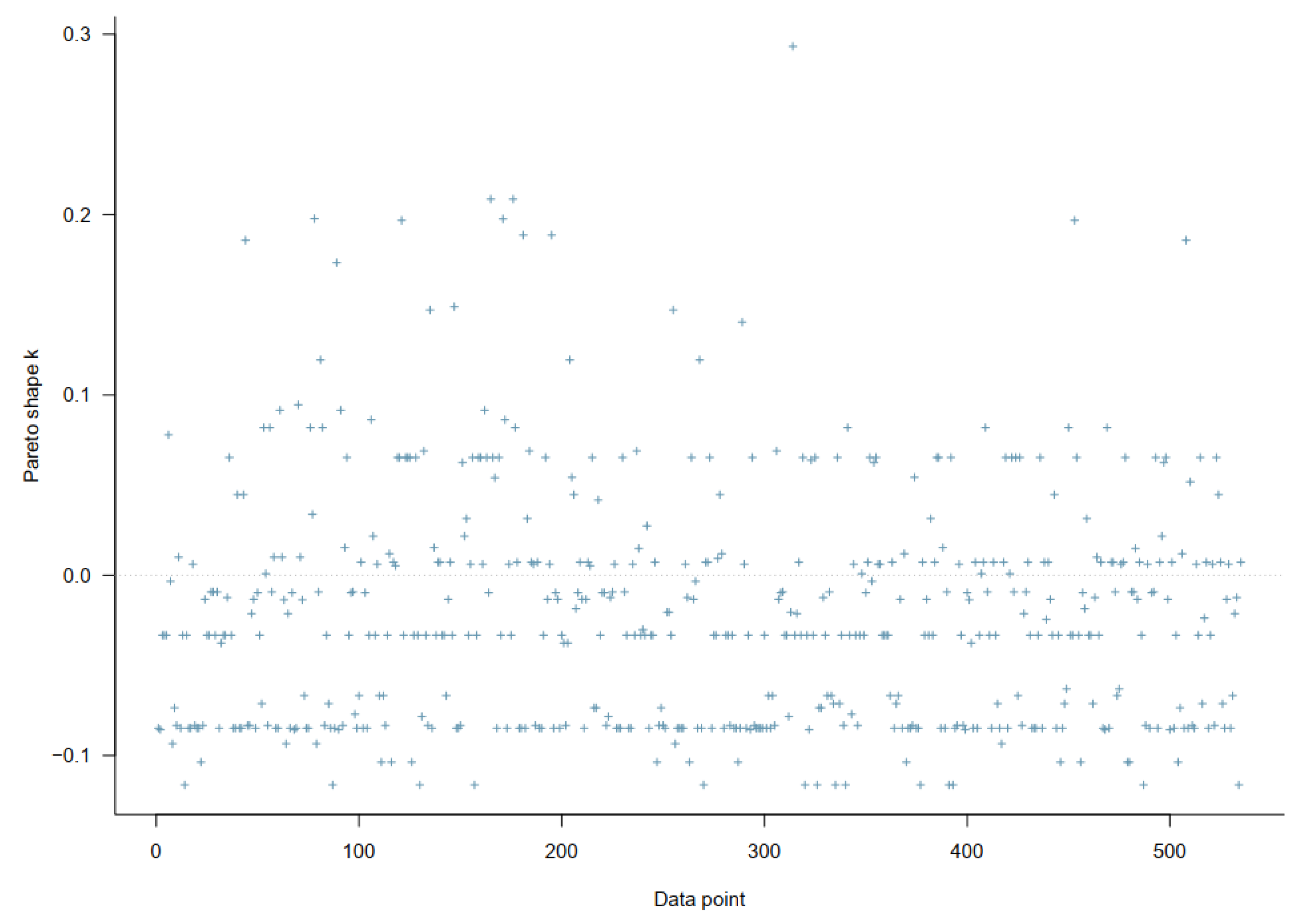
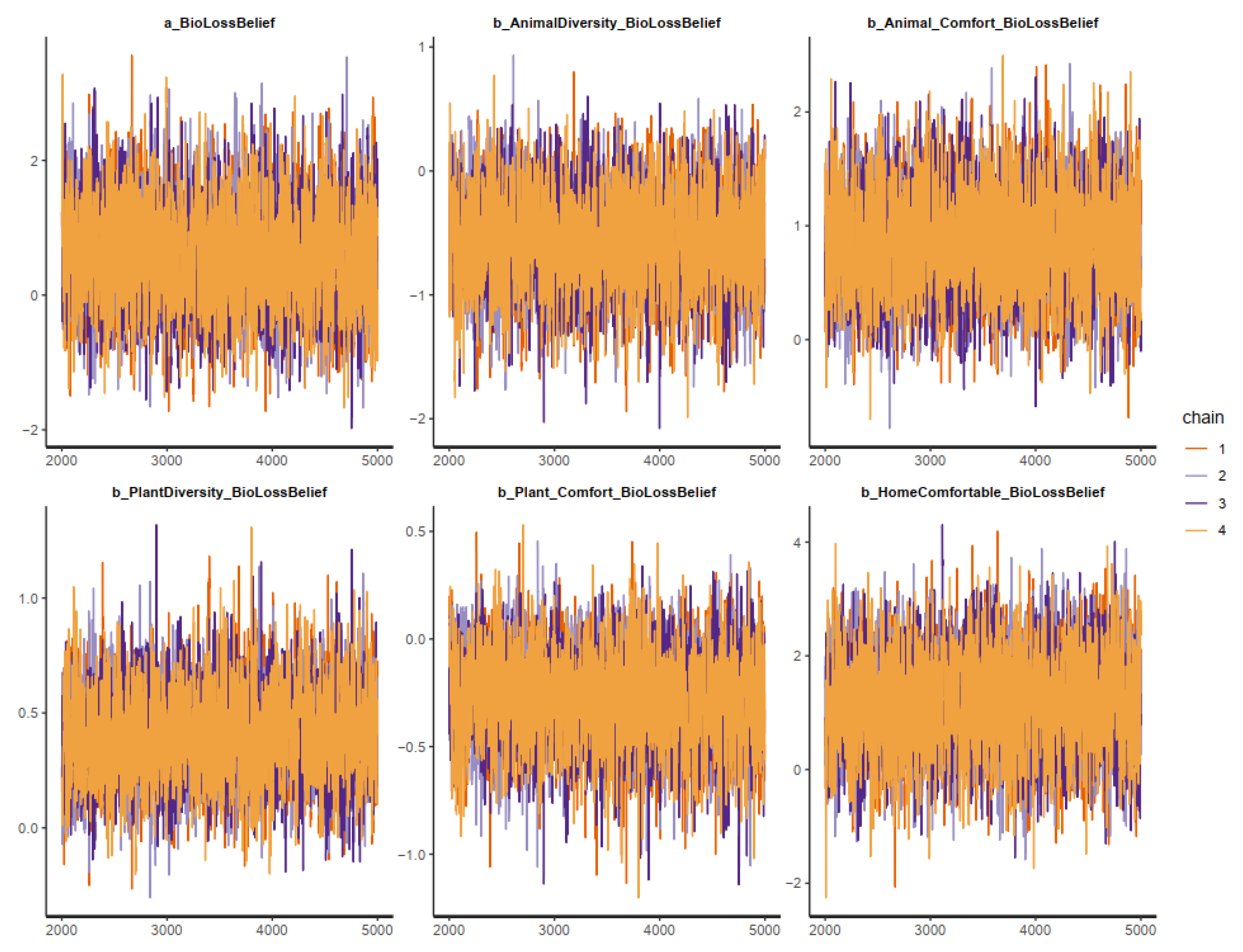
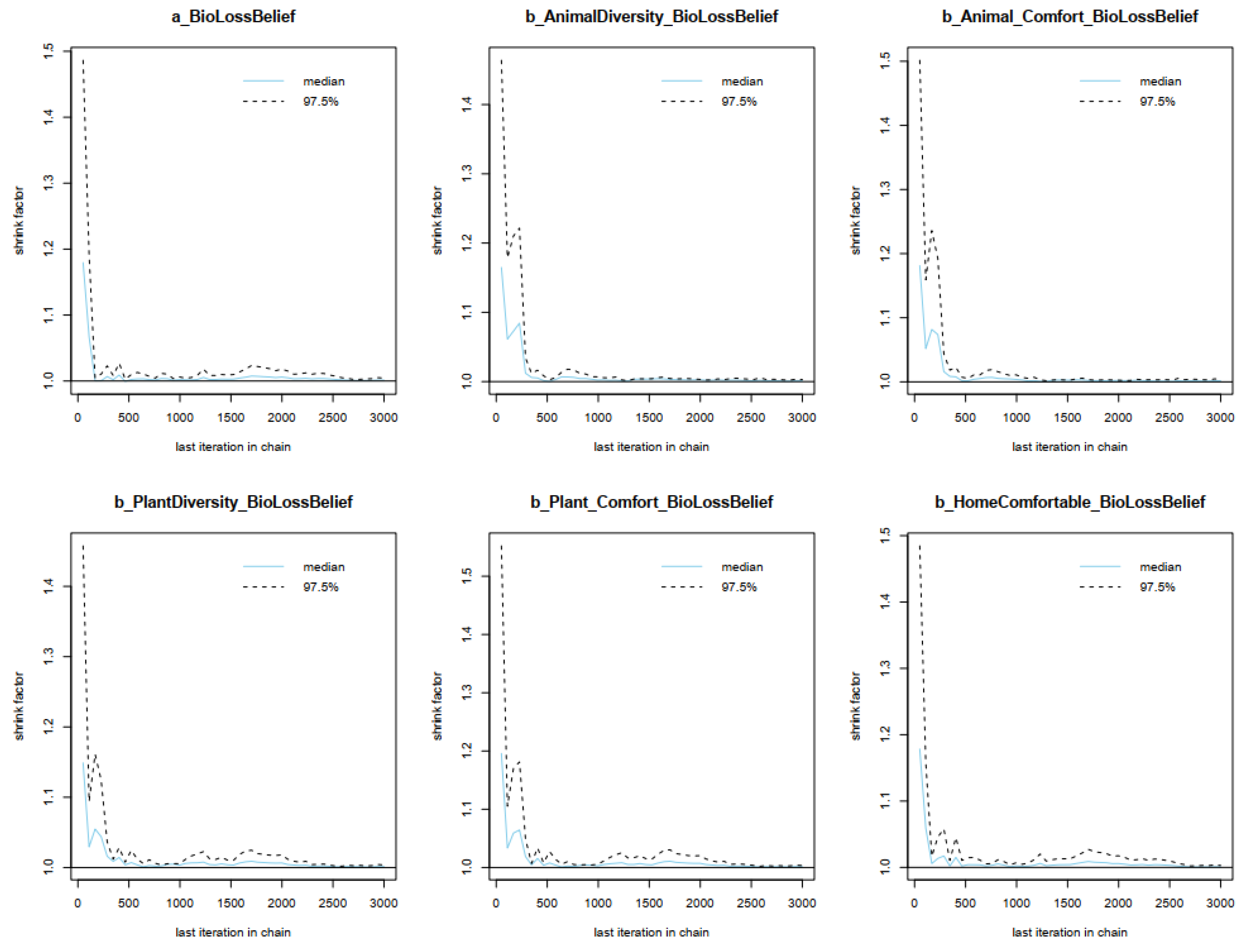
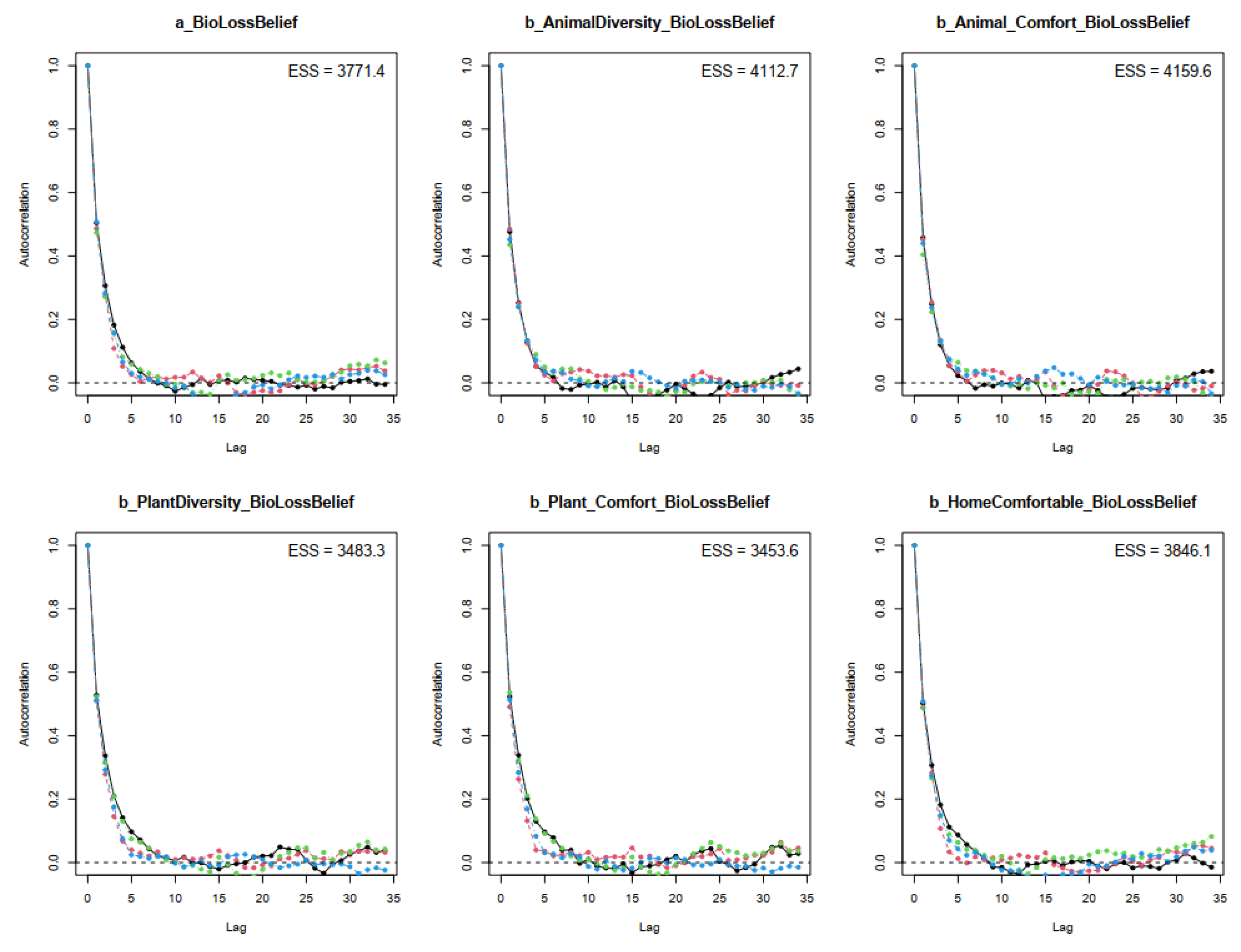

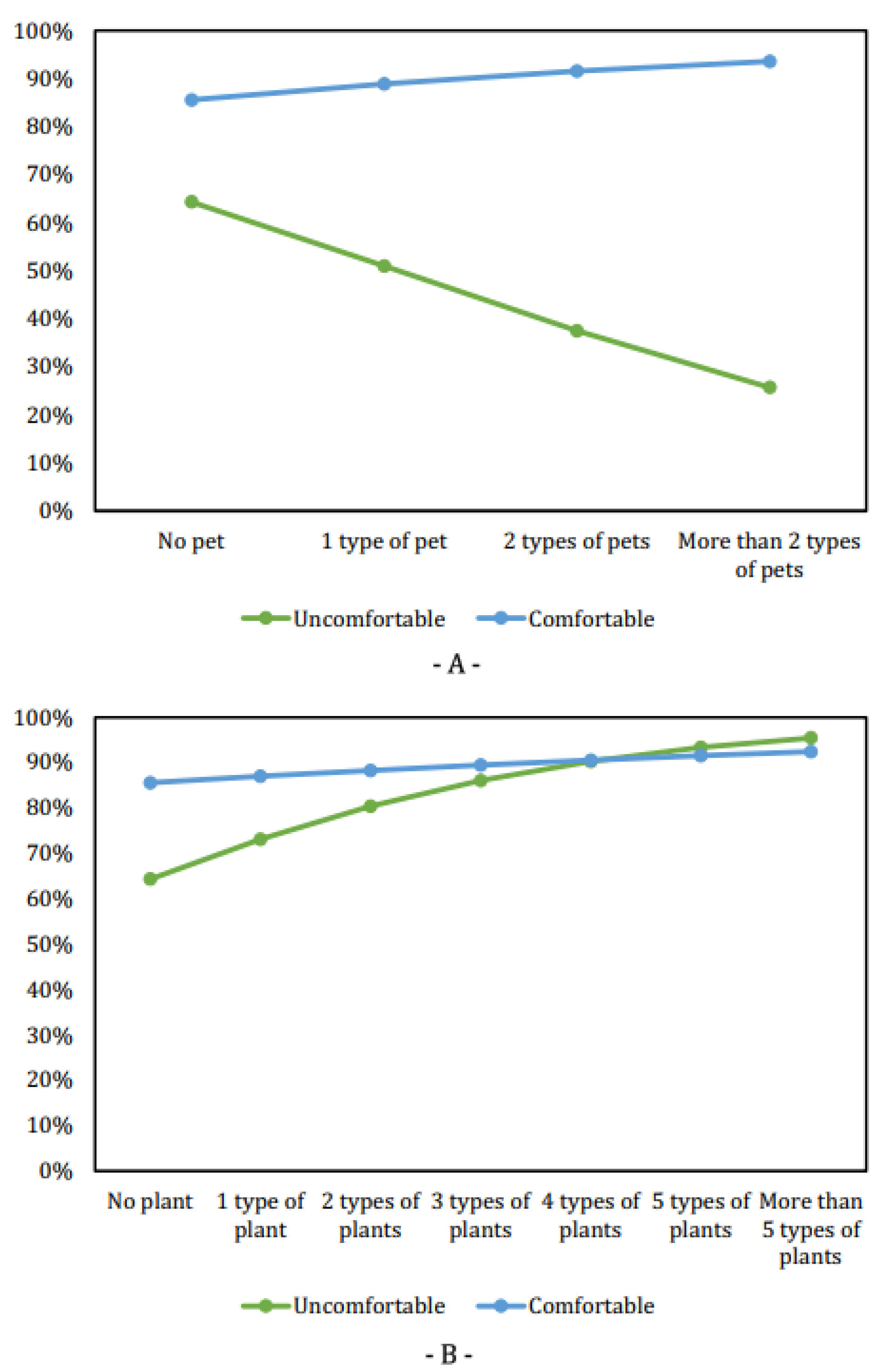
| Variable | Description | Type of Variable | Value |
|---|---|---|---|
| BioLossBelief | Belief in the occurrence and significance of biodiversity loss | Binary | 0: Biodiversity loss is not real or not a big problem; 1: Biodiversity loss is real and a major problem. |
| HomeComfortable | The comfort of respondents in their home | Binary | 0: Uncomfortable; 1: Comfortable. |
| PlantDiversity | The number of types of plants in the respondents’ home | Numeric | Counted based on the number of types of plants |
| AnimalDiversity | The number of pet types that respondents own | Numeric | Counted based on the number of types of pets |
| Weights | WAIC | Pseudo-BMA without Bayesian Bootstrap | Pseudo-BMA with Bayesian Bootstrap | Bayesian Stacking |
|---|---|---|---|---|
| Model 1 | 0.11 | 0.11 | 0.33 | 0.34 |
| Model 2 | 0.89 | 0.89 | 0.67 | 0.66 |
| Most predictive model | Model 2 | Model 2 | Model 2 | Model 2 |
| Parameters | Uninformative Priors | Informative Priors | ||||||
|---|---|---|---|---|---|---|---|---|
| Mean | SD | n_eff | Rhat | Mean | SD | n_eff | Rhat | |
| Constant | 0.59 | 0.09 | 3976 | 1 | 1.28 | 0.48 | 3968 | 1 |
| HomeComfortable | 1.19 | 0.83 | 4044 | 1 | 0.32 | 0.42 | 3949 | 1 |
| PlantDiversity | 0.41 | 0.20 | 3744 | 1 | 0.16 | 0.13 | 3857 | 1 |
| Plant*Comfort | −0.29 | 0.21 | 3855 | 1 | 0.00 | 0.13 | 3958 | 1 |
| AnimalDiversity | −0.55 | 0.37 | 4658 | 1 | −0.22 | 0.25 | 3736 | 1 |
| Animal*Comfort | 0.85 | 0.43 | 4684 | 1 | 0.47 | 0.28 | 3835 | 1 |
Disclaimer/Publisher’s Note: The statements, opinions and data contained in all publications are solely those of the individual author(s) and contributor(s) and not of MDPI and/or the editor(s). MDPI and/or the editor(s) disclaim responsibility for any injury to people or property resulting from any ideas, methods, instructions or products referred to in the content. |
© 2023 by the authors. Licensee MDPI, Basel, Switzerland. This article is an open access article distributed under the terms and conditions of the Creative Commons Attribution (CC BY) license (https://creativecommons.org/licenses/by/4.0/).
Share and Cite
Nguyen, M.-H.; Nguyen, M.-H.T.; Jin, R.; Nguyen, Q.-L.; La, V.-P.; Le, T.-T.; Vuong, Q.-H. Preventing the Separation of Urban Humans from Nature: The Impact of Pet and Plant Diversity on Biodiversity Loss Belief. Urban Sci. 2023, 7, 46. https://doi.org/10.3390/urbansci7020046
Nguyen M-H, Nguyen M-HT, Jin R, Nguyen Q-L, La V-P, Le T-T, Vuong Q-H. Preventing the Separation of Urban Humans from Nature: The Impact of Pet and Plant Diversity on Biodiversity Loss Belief. Urban Science. 2023; 7(2):46. https://doi.org/10.3390/urbansci7020046
Chicago/Turabian StyleNguyen, Minh-Hoang, Minh-Hieu Thi Nguyen, Ruining Jin, Quang-Loc Nguyen, Viet-Phuong La, Tam-Tri Le, and Quan-Hoang Vuong. 2023. "Preventing the Separation of Urban Humans from Nature: The Impact of Pet and Plant Diversity on Biodiversity Loss Belief" Urban Science 7, no. 2: 46. https://doi.org/10.3390/urbansci7020046
APA StyleNguyen, M.-H., Nguyen, M.-H. T., Jin, R., Nguyen, Q.-L., La, V.-P., Le, T.-T., & Vuong, Q.-H. (2023). Preventing the Separation of Urban Humans from Nature: The Impact of Pet and Plant Diversity on Biodiversity Loss Belief. Urban Science, 7(2), 46. https://doi.org/10.3390/urbansci7020046











